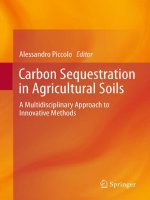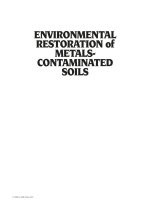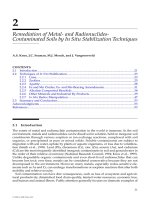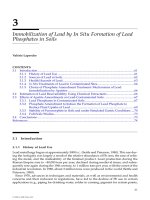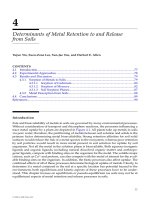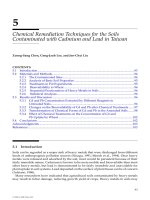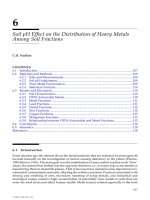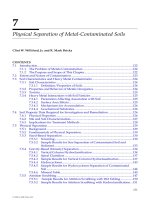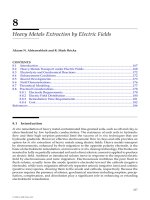43987 rocks soils
Bạn đang xem bản rút gọn của tài liệu. Xem và tải ngay bản đầy đủ của tài liệu tại đây (201.95 KB, 214 trang )
Rocks and Soil
Unit of Study
Wendy Brady
Allyson Stine
OCI 2006
Rocks and Soil Unit
Pre-Test
DIRECTIONS:
This is a pre-test designed to test your prior knowledge. Please read each
question carefully and choose the best answer. Only one answer is correct
so please read all choices before selecting the answer. Take your time!!
1. Rocks are made up of __________________.
A. minerals
B. plants
C. animals
D. water
2. Scientists who study the physical properties of rocks to tell how the
rocks may have formed years ago are called ________________.
A. biologists
B. geologists
C. archeologists
D. anthropologists
3. The property that refers to the way light bounces off a mineral is
called __________.
A. reflection
B. refraction
C. luster
D. streak
4. Which one of these is not a way to identify rocks?
A. streak plate
B. hardness
C. luster
D. weight
5. This type of rock is formed when hot, molten rock material has cooled
and hardened.
A. igneous
B. metamorphic
C. sedimentary
D. gravel
6. A rock formed from bits or layers of other rocks cemented together is
called a ________________________.
A. igneous rock
B. sedimentary rock
C. metamorphic rock
D. gravel
7. A rock that has been changed by heat, pressure or both is called
a___________________.
A. igneous rock
B. sedimentary rock
C. metamorphic rock
D. gravel
8. The never-ending process by which rocks are changed from one type
into another is called_________________.
A. the water cycle.
B. the soil cycle.
C. the rock cycle.
D. the Earth’s cycle.
9. Scientists use clues from these to learn about the past.
A. Animals
B. plants
C. soil
D. fossils
10. Many fossils are found in this type of rock.
A. igneous
B. metamorphic
C. gravel
D. sedimentary
11. Sap can harden into this, trapping insects inside.
A. amber
B. casts
C. rock
C. dirt
12. Which of these body parts is LEAST likely to become a fossil?
A. feather
B. bone
C. shell
D. tooth
13. A vertical section of soil from the surface down to the bedrock is
called a_____________________.
A. rock profile
B. picture
C. soil profile
D. layers
14. Soil begins to form when this starts to break down.
A. sand
B. dirt
C. bedrock
D. air
15. The rate at which water can pass through a substance is called
_______________.
A. flow
B. fast
C. permeability
D. slow
16. Humus comes from______________.
A. bedrock
B. heavy rainfall
C. dead plants and animals
D. clay soil
17. A layer of soil differing from the layers above and below it is called a
__________________.
A. crust
B. fault
C. fragment
D. horizon
18. The space between the soil particles is called___________________.
A. pore space
B. faults
C. cracks
D. crust
19. The layer of soil that is rich in humus and minerals and is usually the
darkest in color is the _____________.
A. subsoil
B. topsoil
C. undersoil
D. horizon
20. In which horizon will you find broken-down bedrock in a soil
profile?
A. Horizon A
B. Horizon B
C. Horizon C
D. Horizon D
LESSON # 1: Introducing Rocks
Objective: Students will explore the physical properties of rocks.
Context: This is the first lesson in this unit of study. It will allow the
students to participate in a hands-on lab activity where they will explore how
rocks are identified and classified.
Connections:
SC-04-2.3.1
Materials:
--5 different rock samples (basalt, sandstone, limestone, gneiss, granite)
--hand lens
--streak plates
--pennies and iron nails
--Science Journal
--Lab Questions
--Rock Test worksheet Grid
PROCEDURE:
Guided Practice:
Students will begin this first lesson by having a teacher-led discussion about
rocks. Some of the questions to inquire will be:
1. What do you know about rocks?
2. Where are they found?
3. What are some of their most common uses?
4. Are there different types of rocks? If so, what are they?
5. Are there any tests to distinguish between rocks?
After spending 10 minutes or so discussing these questions and their
appropriate answers, I will then set up for the Science Lab activity for the
day. While I am doing so, students will be writing down the pre-lab
questions in their science journal.
Concept Development:
I will explain that in today’s Science Lab activity the students will get to
explore the physical properties of 5 different rock samples. We will then
read about and discuss the testing practices of rocks found in our Science
book on page C7.
The tests we will be looking at today include:
1. Luster—which refers to the way light bounces off the minerals in the
rocks. Some are shiny, dull, glassy and even greasy looking.
2. Streak Plate—Gently but firmly rub the mineral down a streak plate.
You often see a streak that is the same color as the mineral’s surface.
3. Hardness—The harder the mineral is, the less likely it will be
scratched. You can test the mineral’s hardness by three ways—a
fingernail, a copper penny, and an iron nail.
4. Color—This is often a good way to classify minerals, but is better
when used in conjunction with the other three above.
Questions for Pre-Lab:
1. What are we studying today?
2. What materials do I need for my experiment/activity?
3. What is the procedure for the experiment/activity?
4. What do I expect to happen? (My hypothesis?)
Independent Practice:
The students will be given a Rock Test Worksheet grid to fill out as they
rotate through the 5 different stations. I will break the students up into five
groups and designate their starting areas. Each group will have
approximately 10 minutes at each station to perform the tests on the rock.
They will then rotate to the next station and perform the same test again, but
on a different rock. Once they have visited all stations, they will return to
their desks and answers the Post-Lab Questions.
5. What happened and why?
6. What did I learn about rocks today?
Assessments:
For the formative assessment, I will be looking at the Science Journal prelab questions to check for accuracy. I will also be using an observation
checklist during the activity to see who is on task and focused. This will
count towards their participation grade.
As for the summative assessment, I will check and grade their Rock
Worksheet Grid and their two post-lab questions. My primary focus is on
question # 6…what did I learn today?
